#cow parsnip
Explore tagged Tumblr posts
Text







Found a creek I didn't really know about today. There's a highway and a big arterial road within a few blocks in either direction. I think this one was dug out of the ground, and not following a course it designed for itself, but the area had been planted with a bunch of natives (and a bunch of other stuff had been given space to grow, too). I was with a friend; it's always nice to discover something you should have known was there, but it's especially nice if it's with a person you know will smile fondly at you when you get excited about duckies.
#original photography#photographers on tumblr#photographers of tumblr#sonya7riv#sonya7r4#landscape#fauna#flora#green#ducks#cow parsnip#beetles#avian#invertebrates
106 notes
·
View notes
Text

Lace in a Mountain Meadow
(c) riverwindphotography
459 notes
·
View notes
Text

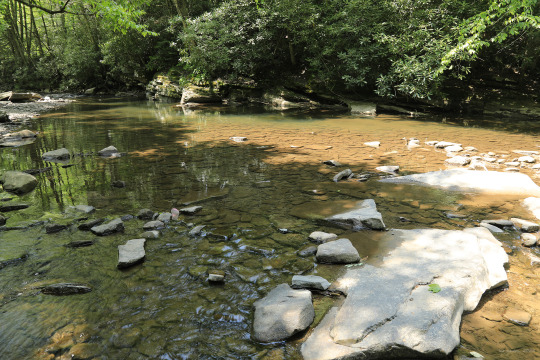
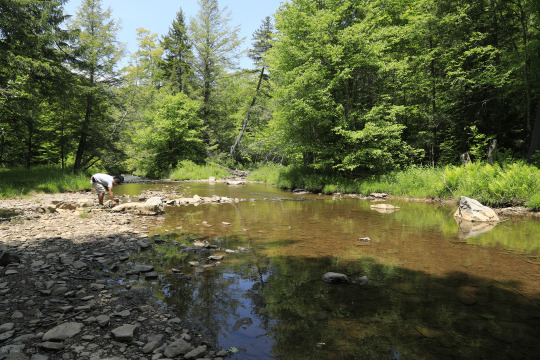
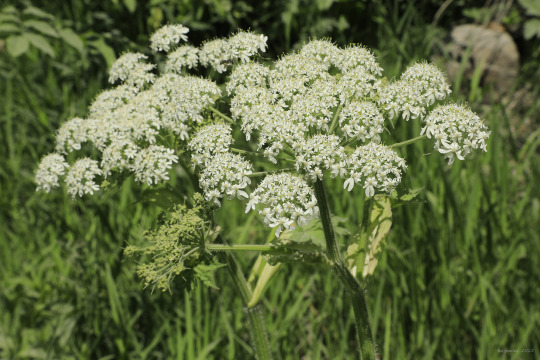
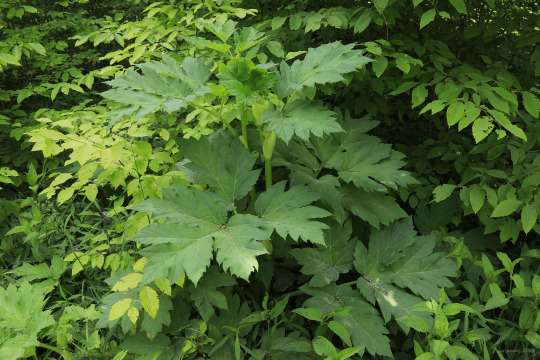
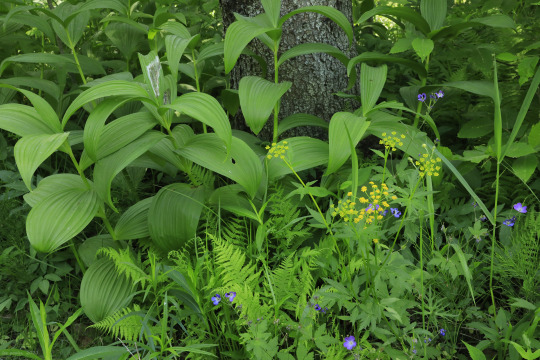
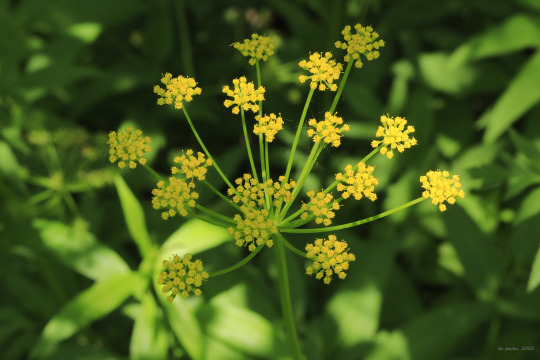

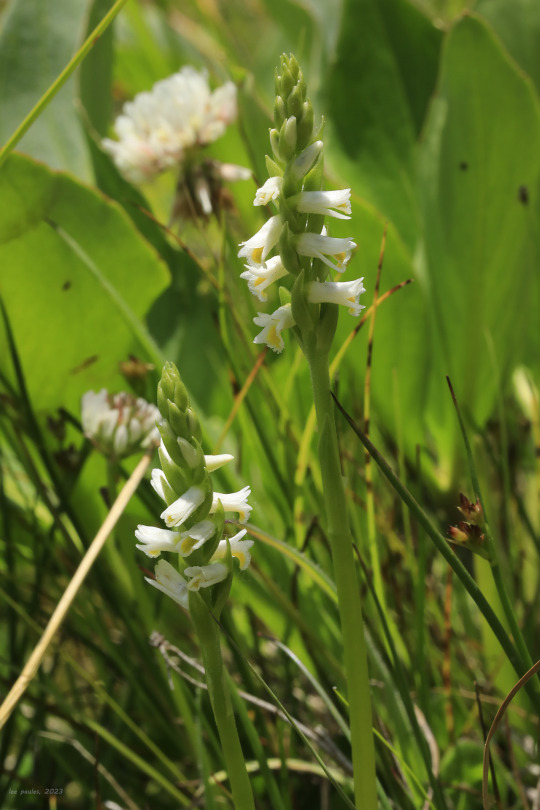
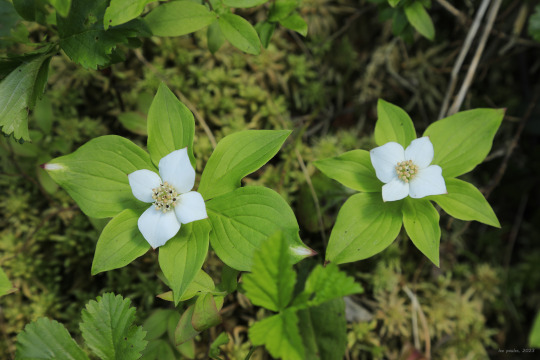

Day Date at Spruce Knob-Seneca Rocks National Recreation Area, Part 1. Most couples would probably equate a "date" to a nice dinner out and a Marvel adventure movie, but Blake and I, being hopeless nature fanatics and aspiring satyrs without hooves, equate it to mean "putzing around in the mountains". The timing was perfect: the haze from the Canadian wildfires, which has been choking most the US Mid-Atlantic and Northeast for the past week, had mostly moved on, replaced by a crisp blue sky with a light breeze.
From top: the view from the Rich Mountain Overlook on Old Route 33, heading toward Harman; Blake communing with the mystic creek chubs in Gandy Creek, one of the best brook trout streams in the Mid-Atlantic region; cow parsnip (Heracleum maximum), a mildly phototoxic beauty that Native Americans relied on for food and medicine; a forest composition of false green hellebore (Veratrum viride), ferns, wild geranium (Geranium maculatum), and golden Alexander (Zizia aurea); a close-up of golden Alexander, a lovely, spring-blooming member of the carrot family; the wetlands complex at Spruce Knob Lake; shining ladies' tresses (Spiranthes lucida), a spring to early summer-blooming bog orchid recognizable from its bright yellow labellum; bunchberry (Cornus canadensis), which can be easily mistaken for a spring-blooming forb but is actually a dwarf dogwood; and a feisty eastern garter snake (Thamnophis sirtalis sirtalis), whose saliva contains a mild neurotoxin that is deadly to its prey but harmless to humans.
#appalachia#vandalia#west virginia#wildflowers#spring#flora#allegheny mountains#monongahela national forest#spruce mountain#spruce knob lake#gandy creek#spruce knob-seneca rocks national recreation area#reptile#snake#eastern garter snake#cow parsnip#false green hellebore#wild geranium#golden alexanders#golden zizia#golden alexander#shining ladies' tresses#bunchberry#creeping dogwood#canadian dwarf cornel
136 notes
·
View notes
Text

At the cow parsnip patch
11 notes
·
View notes
Text




Kletzsch Park, Glendale WI (2) (3) (4) by Douglas Fox
2 notes
·
View notes
Text
Chemistry behind Giant Hogweed
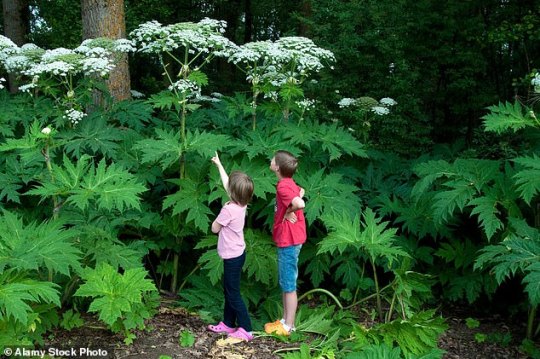
Giant hogweed (Heracleum mantegazzianum), also known as "cow parsnip," is a perennial herbaceous plant in the Apiaceae family. It is native to the Caucasus and Central Asia and was introduced to the United Kingdom as a horticultural plant in the 19th century. The entire giant hogweed plant contains furanocoumarin compounds, with the main components methoxsalen, psoralen, and bergapten🌿⚠️.



These compounds have a unique feature - they're phototoxic! 😱 When the plant's sap comes in contact with your skin and is exposed to sunlight (UV radiation), it can cause "phytophotodermatitis" - an intense reaction that resembles a burn. 🔥
The symptoms include redness, swelling, blistering, pigmentation, and scarring that can last for months. 😫If exposed to giant hogweed sap, the best course of action is to immediately rinse the affected area with a large amount of water, cover it with clothing to avoid exposure to bright light and seek medical advice from a healthcare professional if the symptoms are severe.
#giant hogweed#heracleum#plant#cow parsnip#organic chemicals#chemistry#science#compound#kingdraw#organicchemistry#molecule#toxic plants#take care out there#did u know#interesting facts
5 notes
·
View notes
Text


Heracleum maximum or cow parsnip in flower and beginning to set fruit. You can see they are primarily pollinated by flies
4 notes
·
View notes
Text
The Small Things Spreading Joy in September 2023
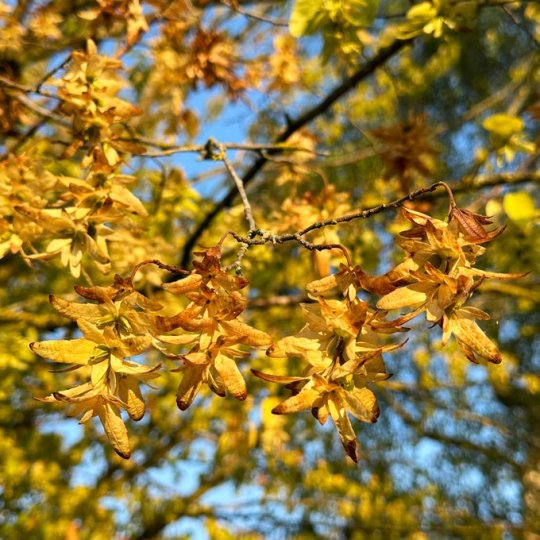
View On WordPress
#Apples#bay tree fruit#blackberries#cow parsnip#cyclamen#dogwood berries#fallen leaves#fallow deer#hawthorn#hogweed seeds#hornbeam catkins#hummingbird sage#lime tree seeds#lords and ladies#mist covered oak tree#my photographs#old man&039;s beard#pines#rose hips#spreading joy#sweet pea#The Small Things#thistles#traveller&039;s joy#tree stumps#wisteria
1 note
·
View note
Text

April 1st, 2025
#bluebellyphotos#cow parsnip#hills#original photography#photographers on tumblr#photographers of tumblr#sonya7riv#sonya7r4#flora#green#landscape#botanical
33 notes
·
View notes
Text
itis very funny i post so much abt myself but i dont actually post that much abt what goes on day to day . mainly bc there isnt much but like. u guys arent even aware of mine and lamps current music phase .. crazy
#well i thnnk ive mentioned it. were very jnto kpop atm weve been watching a lot of videos ive added like 30 new songs to my playlsit snd#theyre all kpop. its fun#we arent rly into any of the like . fandom part of it FNFNJF neither of us rly do fandom at all im reformed and lamp never rly has. but yes.#there r like 8 kpop songs on my on repeat atm which ik doesnt seem like a ton but its bc i tend to just listen to the same 3 songs on repeat#for days on end#currently villain by pixy is going platinum. and nobody knows by kiss of life is huge. and maria by hwasa and hip by mamamoo were big...#SOO yes. and theres many others...#we just watch those big comp videos and then grab whatever we like.and today we watched a lot of the dance practice videos bc theyre fun 2#watch#but ya. itis fun. its also fun bc like. obv since were watching like. fancomps we get to like peoplewatch kpoppies which is fun. except when#it isnt but then we just dont look at the comments#umm and today we played more stardeww we finally finished the first year in our save. i mentioned potato bix earlier its the deeply#controversial new farm layout#we only had 30 strawberry seeds from last year skullllll. so its very potato heavy hence the name#its like. i think. 2 6x13s + 2 21x3s. but the 21x3s have sprinklers#and then other assorted crops in the middle and then lamps got like a few up by their house but theyre all sprinkled#it does look like ass. and the profits Will not even be that good. BUT ! our fortunes will turn come blueberry day <- famous joke with me#and lamp. more common variation our fortunes will turn come cranberry day#i will say spring in sdv is like back to school like winter is for kicking it and playing around and then its spring and its like fuckk. we#have to do everything there is#but were almost done with all the bundles we have to get fuckass red cabbage so itll be fall b4 its done#weve got 2/3 apples just from the batcave so thats nice#and aside from that we need like 3 more gold parsnips and then a few animal goods. like i think we need 2 of 3. of large milk large goat#milk and duck egg. and we just got cows and a duck#nd thennnn well be getting the goat soon..#und then well prolly fully update the barn and coop#weve got most of our tools to gold except like. an ax and i think lamps pan needs another upgrade. weve even got the trashcans gold now#nd then eere gonna hold off on iridium bc 1 we dont have much 2 were sabing for sprinklers for when we get the greenhouse and 2 expensive.#itll have to wait for BLUEBERRY DAYYYY which willt ake a while#and then probably well just work on fully upgrading the house and all this.
1 note
·
View note
Text

Cow parsnip (Heracleum maximum) lights up the pine forest, Gibbon River, YNP
(c) riverwindphotography, July 2024
847 notes
·
View notes
Text
~Charades~
You play charades with the 141 lads.

“We should play charades,” it was a small suggestion, half-jokingly. You were locked up in a random corner of the world were Wi-Fi, and entertainment was scarce.
The boys had agreed.
You and Soap offered to be the smaller team if you could work together.
Worst mistake of the boy's life. You had all chucked in bets and items you had brought on deployment. Sweet foods, beers, money and even an unfinished sudoku was on the line.
You all threw pieces of paper with random things written on them into a hat which you would draw from. Both teams tried to write items that only their team would know.
It didn't help the other team in the slightest.
You each had one minute to guess the most items. First it was the other teams go. They got a few and stumbled over a questionably worded one.
Then it was your and Soap's time to shine.
Soap opted to be the charader and you the guesser. Soap shook out his body cracking his neck as he got ready. Your expression were deathly serious as you readjusted in the seat moving forward to place your wight on your knees.
“They are way to serious for this,” Gaz grinned at the others.
“Shut up,” you snapped.
“Alright ready? Start!” Price stated the timer.
“Bacon,
Cigars
Rocket launcher
Swiss cheese
Fucking BRITS!
Laswell!
Highland cow!
FLUFFERNUTTER!
Bruce Springsteen!
Parsnips! NO! BUSELSPROUTS!
PRICE!” in a rapid-fire succession Soap shot out barely one movement before you guessed it.
“Time!” Price announced. In excitement you stood, pumped full of adrenalin.
“FUCK THE BRITS!” Soap exclaimed in excitement.
“FUCKEN OATH!” you yelled as you clasped hands before chest bumping.
“How the hell did they do that?” Gaz asked as bewildered as the others.
“They cheated,” Ghost shrugged.
“Fuck off,” you grinned.
“I don't know. That seemed mighty specious,” Price shrugged.
“You lot don't understand. The lass and I have a connection. Synced at the mind,” Soap explained half serious tapping his temple.
“Of course they wouldn't understand. They're British,” you said patting Soaps shoulder, shaking you head like you had just heard some difficult news.
“There is no way you didnt cheat,” Gaz shock his head.
“Oh you dont belive us do you?” You asked.
“How about this. I've got one more. It hasn't been written down so there no way she could have known it. If she gets it in under a second you all have to admit we won fair and square,” Soap proposed the idea. The lads looked at each other. It was a worthy gamble.
“Fine,” Price nodded.
You got ready once again Soap rubbing his hands together as you prepared yourself. You propped yourself on your knees as you stared at him.
“You fuckers watching?’ Soap asked.
“We're watching,” Gaz said.
“Good cause your about to see some real fucking magic,” you stated.
“Alright Price count us down,” Soap ordered.
“3, 2, 1,” Price said. Soap rose to his full height, holding both his hands up in ok sighs. His eyebrows raised, and he blew his cheeks out with a huff.
“SIMONS ASS!” You screamed at the top of your lungs.
Let's just say you guys won.
================================================
--COD Master List Here--
================================================
#141 x reader#141 x you#cod 141#cod ghost#ghost x reader#simon ghost riley#simon ghost x reader#task force 141#tf 141#simon riley x reader
524 notes
·
View notes
Text
A Recipe for Daropaka and a Korithian Meal

Hello everyone! (More than) A few days ago I said that, as a way to celebrate reaching 200 followers that I would make one of the dishes from the setting of my WIP. I did something similar for 100 followers which you can see here. This time around I put up a poll to see what dish you all would like to see based on the favorite dishes of my OCs. You voted for Otilia's favorite food, a cheesecake (Daropaka) from the land of Korithia.
However because I felt a bit bad about how long it took me to get to this and because I needed to make something for dinner anyway, I prepared an entire Korithian meal, specifically the last dinner Otilia ate before she left her homeland.
I will give a short description and some history for each component of the meal and will also provide recipes. These recipes come specifically from the Korithian city-state of Kalmanati.
BIG POST ALERT

The diet of Korithians is highly reliant on cereals, grapes, and olives. Barley is the most commonly consumed cereal and is used in the bread of most commoners. However, Kalmanati is famed for the quality of its wheat, and particularly among the wealthy, wheat is the cereal grain of choice. Legumes (Lentils, peas, vetch, beans, etc), vegetables (Cabbage, carrots, lettuce, seaweeds, artichokes, asparagus, onions, garlic, cucumber, beets, parsnips, etc.) and fruits/nuts (pomegranate, almond, fig, pear, plum, apple, dates, chestnuts, beechnuts, walnuts, rilogabo(Kishite regalu "Sunfruit"), bokigabo (Kishite botagalu "Northern fruit), etc.) also make up a significant portion of the Korithian diet, with meat (Cattle, lamb, pig, goat, goose, duck, horned-rabbit, game) and fish typically filling a relatively minor role except for in the diets of wealthy individuals (like Otilia).
Vinegar, oil, and garlic appear in almost all Korithian dishes and are an essential aspect of the Korithian palate.
Recipes below the cut!

The components of the meal are as follows:
Daropaka: (Korithian: Daro = cheese, paka = cake)
Karunbarono: (Korithian: Karun = meat, baro = fire (barono = roasted) )
Pasrosi Diki: (Korithian: Pasrosi = fish(es), Diki = small)
Psampisa : (Korithian: Psamsa = bread, episa = flat)
Akuraros : (Korithian: Akuraros = cucumber)
Ewisasi : (Korithian: Ewisasi = olives)
Funemikiwados: (Korithian: Funemiki = hill (mountain diminutive), wados = oil/sauce)
Wumos: (Korithian: Wumos = wine)
Daropaka aka Awaxpaka aka Korithian Cheesecake
Daropaka is a popular dessert in Korithia, however its origins predate Korithia by several thousand years.
The dish originates from a race of forestfolk living on the Minosa, known as the Awaxi. The Awaxi were a tall and powerful race, some rivaling even demigods in size. Aside from their size the Awaxi were also easily identifiable by the third eye which sat on their forehead and the porcupine like quills which grew from their shoulders, sometimes called the Awaxi mantle.
The Awaxi were a primarily pastoralist civilization, living in small semi-temporary communities where they raised cattle and goats. They are credited with inventing cheese.
The first humans that the Awaxi came into contact with were the Arkodians. The Arkodians introduced the Awaxi to metallurgy, and in exchange the Arkodians were given knowledge of the cheesemaking process. This early form of cheese was called darawa (Korithian: Daro) and was typically made from cow's milk and vinegar, the resulting cheese being soft and crumbly, similar to a ricotta.
Unfortunately peace would not last. The Awaxi settled disagreements and debates often through duels, rather than through war. While quite skilled duelists, their culture had no reference for strategy in battle and lacked the proper skills to fend off the organized assault from imperialistic Arkodians. The Awaxi were eventually driven to extinction, though they still appear as monsters in Korithian myth.
The Arkodians themselves would later fall, destroyed by the Kishites, however many of their recipes, including their recipe for cheesecake, would be passed down to their descendants, the Korithians.
Recipe
(Note that Korithia has no distinct set of measurements nor are recipes recorded. Recipes are typically passed down orally and differ greatly between regions and even families. Adjust ingredients to one's own liking) (Also note that this is not like a modern cheesecake, as it utilizes a ricotta like cheese the texture will not be as smooth and it doesn't use eggs as chickens have not yet been introduced to Korithia)
The Cheese
1/2 Gallon of Whole Cow or Goats Milk
1 Pinch of Sea Salt
2 Bay leaves
2 Tablespoons of White Vinegar
1 Large Ripe Pear
6 Tablespoons Honey
2 Tablespoons White Wheat Flour
1 Tablespoon Rilogabo Juice (substitute 1:1 Orange and Lemon juice)
The Crust
1 Cup White Wheat flour
Water, Warm
1 Pinch of Sea salt
The Topping
1 Sprig Rosemary
3 tablespoon honey
2 tablespoon rilogabo juice (see above)
1 Large pear (optional)
Fill a pot with milk. Stir in salt and add bay leaves. Heat over medium heat until milk registers around 190 F, do not allow to boil. Look for slight foaming on the surface, when the temperature has been reached, remove the bay leaves and add vinegar, the curds will begin to form immediately, stir to fully incorporate vinegar without breaking curds. Stop.
Take the pot off of the heat and cover, allow it to sit for 15 minutes.
Using cheesecloth, a fine mesh strainer or both, separate the curds from the whey. Allow the curds to cool and drain off excess liquid.
Preheat the oven to 410 F or 210 C. Grease the bottom and sides of an 8 inch cake pan with olive oil.
While cheese is draining, make the crust. Knead the white wheat flour with a pinch of salt and warm water for about 15-20 minutes, until obtaining a smooth consistency. Roll a thin circular sheet larger than the cake pan. Lay the dough inside, trim off any dough which hangs over the edge of the pan.
Skin and seed 1 large pear, using either a mortar and pestle or a food processor, break the pear down into a paste or puree, there should be no large visible chunks.
Combine drained cheese, 6 tbsp honey, pear puree, flour, and rilogabo juice. Using a food processor or other implement combine ingredients until a smooth texture is achieved. Taste and add honey accordingly
Pour the mixture into the pan, careful not to exceed the height of the crust. Top with a sprig of rosemary and place into the oven.
Cook for 25-30 minutes or until the filling has set and the surface is golden.
Make the topping by combining 3 tablespoons of honey and the remaining rilogabo juice.
Remove cake from the oven and pour the topping over the surface. Allow the cake to cool
Serve warm, cold, or room temperature with fresh fruit.
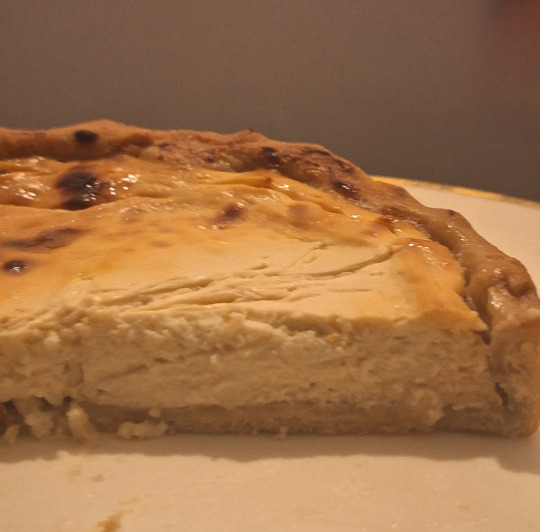
Karunbarono aka Roasted Meat
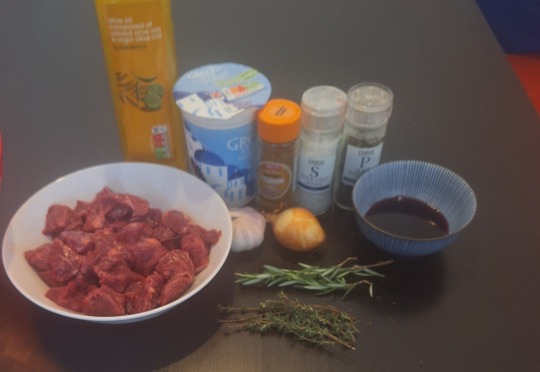
Cooking meat on skewers is a staple of Korithian cuisine, so much so that in certain regions the metal skewers or kartorosi, can be used as a form of currency. Meat is typically cooked over an open fire or on portable terracotta grills, though it is not unheard of to use a large beehive shaped oven or baros. The majority of the meat eaten by the lower classes comes in the form of small game such as rabbit or sausages made from the scraps of pork, beef, mutton, poultry, and even seafood left after the processing of more high-class cuts. The chicken has not yet been properly introduced to the islands, though some descendants of pre-Calamity chickens do exist, though they in most cases have drastically changed because of wild magic. Animals are rarely eaten young, lambs for example are almost never eaten as their potential for producing wool is too valuable. Most animals are allowed to age well past adulthood, except for in special circumstances. The practice of cooking meat in this style is prehistoric stretching back far before Korithia or Arkodai. What is newer however is the practice or marinading the meat before cooking it, this is a Korithian and later Kishite innovation.
Recipe
1 lb Mutton (meat used in this recipe), beef, lamb, venison, or horned-rabbit meat (in order to achieve this it is suggested to use wild hare meat in combination with pork fatback) chopped into bite sized pieces
4 Tablespoons Plain Greek Yogurt
4 Tablespoons Dry Red wine (Any dry red will work, for this recipe I used a Montepulciano d'abruzzo but an Agiorgitiko would work perfectly for this)
3 Tablespoons Olive Oil
4 Cloves of Garlic roughly chopped
1 Small onion roughly chopped
1 sprig fresh thyme
1 sprig fresh rosemary
1 tsp sea salt
1 tsp black pepper
1/2 tsp ground cumin
Gather and measure ingredients
Combine everything into a large bowl and stir, making sure that all pieces of meat are covered in the marinade.
Cover and allow meat to sit, preferably in the fridge for 2 hours or up to overnight.
Well the meat is marinating, if using wooden or bamboo skewers, soak in water for at least one hour to prevent burning.
Preheat the oven to 400 F or roughly 205 C. Or if cooking an open fire, allow an even coal bed to form.
Remove meat from the fridge, clean off excess marinade including any chunks of garlic or onion
Place meat tightly onto the skewers making sure that each piece is secure and will not fall off.
Brush each skewer with olive oil and additional salt and pepper to taste, optionally add a drizzle of red wine vinegar.
Place on a grate either in the oven with a pan below it to catch drippings or else over the fire. Allow to cook for 10-20 minutes depending on how well you want your meat cooked (less if using an open fire) Check every five minutes, flipping the meat after each check.
Remove from the oven and serve immediately.
Pasrosi Diki aka Little Fishes

Despite living by the sea, fish makes up a surprisingly small part of most Korithians' diet. The most valuable fish typically live far away from shore, where storms and sea monsters are a serious threat to ships. Much of the fish that is eaten are from smaller shallow water species, freshwater species, or shellfish. Tuna, swordfish, sturgeon, and ray are considered delicacies, typically reserved for the wealthy. Marine mammals such as porpoise are eaten on rare occasions, typically for ceremonial events. Pike, catfish, eel, sprats, sardines, mullet, squid, octopus, oysters, clams, and crabs are all consumed by the poorer classes. Sprats and sardines are by far the most well represented fish in the Korithian diet, typically fried or salted, or even ground and used in sauces. This particular recipe makes use of sprats. Unlike their neighbors in Baalkes and Ikopesh, Korithians rarely eat their fish raw with the exception of oysters.
Recipe
(Note that unlike modern recipes using whitebait, these are not breaded or battered as this particular cooking art has not yet been adopted in Korithia, though it is in its infancy in parts of Kishetal)
10-15 Sprats (other small fish or "whitebait" can also be used)
2 quarts of olive oil (not extra virgin)
Sea salt to taste
Black Pepper to Taste
Red Wine Vinegar to taste
Gather ingredients
Inspect fish, look for fish with clear eyes and with an inoffensive smell, avoid overly smelly or damaged fish.
Pour olive oil into a cast iron skillet or other high sided cooking vessel and heat to approximately 350 F or 177 C.
Fry the fish in batches of 5, stirring regularly to keep them from sticking. Cook for 2-4 minutes until the fish have started to crisp. Be careful, some fish may pop and spit.
Remove fish from the oil and allow them to drain.
Season fish with salt, pepper, and vinegar and serve.
Psampisa aka Flatbread
There are many varieties of bread eaten in Korithia and grain products make up anywhere from 50 to 80 percent of an average individuals diet. This particular variety of bread is most popular in the southern and eastern portions of Korithia, whereas a fluffier yeasted loaves are more commonly eaten in the west and north. This recipe is specifically made with wheat but similar breads can also be made with barley or with mixtures. If you do not want to make this bread yourself it can be substituted with most pita breads. Bread is served with every meal and some meals may feature multiple varieties of bread.
(Note for this recipe I only had self-raising flour at hand which gives a slightly puffier bread, if this is what you want add roughly 3 tsps baking powder)
Recipe
2 1/2 cups white wheat flour plus more for surface
1 1/2 teaspoons sea salt
1 cup whole fat greek yogurt
Olive oil for cooking
In a large bowl, mix together the flour, salt and baking powder. Add the yogurt and combine using a wooden spoon or hands until well incorporated
Transfer the dough to a lightly floured surface and knead by hand for 5 minutes until the dough feels smooth.
Cover the dough and allow to sit for approximately 20 minutes
Separate dough into desired number of flatbreads.
Add flour to each dough ball with your hands and then use a rolling pin to flatten out the dough on a lightly floured surface. Size is up to taste.
Heat a pan on medium high heat. Add the olive oil and cook the flatbreads one at a time for about 2-4 minutes, depending on thickness, per side until the bread is puffed and parts of it has become golden brown.
Akuraros aka Cucumber (Salad)

While the cucumber has become a relatively popular crop within Korithian agriculture it is not native and was all but unknown to their Arkodian predecessors. Cucumbers, which actually originated in Sinria and Ukar, were introduced by Kishite invaders during the Arko-Kishite war and were subsequently adopted by the survivors of that conflict. Cucumbers are associated with health and in particular with fertility. Cucumbers are typically eaten raw or pickled. They may be used in salads or even in drinks, ground into medicinal juices. Cucumbers are additionally believed to ward off disease carrying spirits and may be hung outside of the doors of sick individuals to ward off evil entities. Cucumbers are also fed to learning sages, as they are believed to strengthen the resolve and spirit. A potion consisting of the magical herbs wumopalo and lisapalo, wine, and cucumber juice has historically been used to temporarily induce in non-sages the ability to see spirits. Dill is additionally believed to produce positive effects, thought to ward of diseases of the stomach and cancers. Dill is often used in potions which may effect the physical nature of an individual, these potions are rarely used as their effects are most often permanent to some extent.
This particular cucumber salad recipe is a favorite in the region around Kalmanati, Bokith.
Recipe
1 large cucumber cleaned
2 cloves garlic roughly chopped
2 tablespoons fresh dill chopped
1/3 cup red wine vinegar
1/4 cup extra virgin olive oil
Salt to taste
Pepper to taste
Cumin to taste
Cut cucumber into thin slices (the actual width will vary dependent on taste)
Combine cucumber and all other ingredients in a non-reactive container and mix.
Cover and store the salad for at least 30 minutes and up to 12 hours.
Serve cold
Ewisasi aka Olives
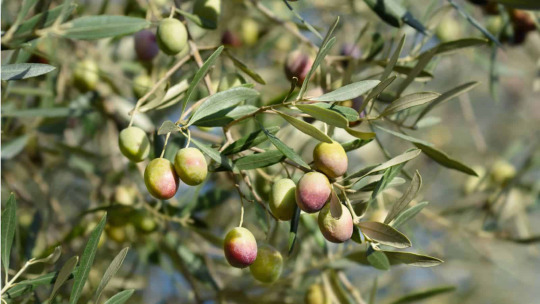
The Ewasi or olive is in many ways the center of Korithian cuisine, as it is also in Baalkes and Knosh. Olive oil is used regularly and the olive fruit is consumed at all meals of the day including dessert. Olives are cured via the use of water, vinegar, brines, or dry salt in order to remove their innate bitterness. There are hundreds of varieties of olive in Korithia alone, their taste dependent on when they are harvested, how they are cured, the particular cultivar, and even the soil in which they are grown. Kalmanati is best known for two varities of olive, the kalmi, which is red fleshed and meaty, typically cured in red wine vinegar, and the prasiki, a small green olive which is firm and slightly nutty in flavor.
Recipe
Take your favorite olives, put them in a bowl. Optionally add vinegar and herbs
Funemikiwados aka Hill Sauce
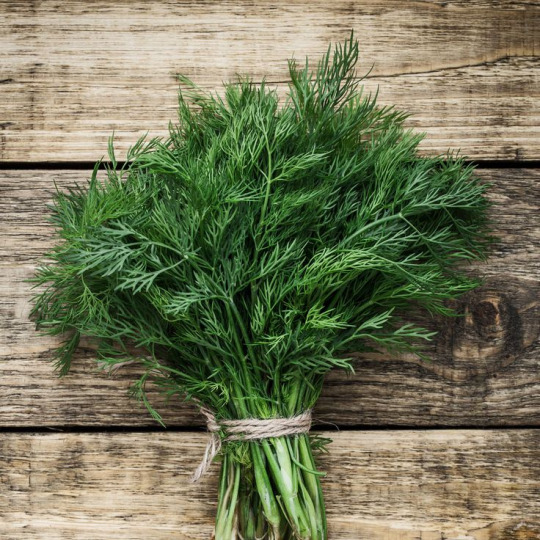
Hill sauce is the condiment of choice for most Korithian households and the exact nature of the sauce will vary greatly from region to region. In the north it is most often composed of pine nuts, olive oil, onion, vinegar, salt, and garlic. In the south the sauce is typically far more marine in nature, composed of seaweed, fish, garlic, olive oil, and vinegar. In all cases the ingredients are combined and mashed or ground to produce a pourable/dipable sauce. The sauce itself originates from the center of Korithia around the city of Bokakolis. The sauce was originally used by shepherds to flavor dried meats which may otherwise be dry or flavorless. Its name derives from the ingredients used within these early versions of the sauce, many of which were herbs plucked from the hillside while the shepherds tended to their flocks. The Kalmanatian version of the sauce is similar to this original herb based variety however it adds salt-cured fish and tisparos (Tisi - tickle, paros- seed) , another Kishite import (there it is called lisiki). This sauce is often used with practically any savory food, poured on meat, fish, vegetables, and bread. Often a house may be judged by the quality of their funemikiwados. Among the Kalmanatians there is two varieties of the sauce, a fresh version (the one described here) and another which is typically made with dried herbs and has additional vinegar added to act as a sort of preservative.
Recipe
1/2 cup extra virgin olive oil
1/3 cup red wine vinegar
2 tbsps rilogabo juice (1:1 orange and lemon)
2 anchovies (or other small salt-cured fish)
1/4 cup fresh chopped dill
1/6 cup fresh chopped parsley
1/8 cup fresh chopped thyme
6-10 leaves of fresh chopped rosemary
2-3 leaves fresh basil
2 cloves of garlic
Black pepper to taste
Ground tisparos to taste (Substitue ground sichuan pepper)
Gather the ingredients.
Combine and grind anchovies, garlic, and herbs into a fine paste, using a mortar and pestle or with a food processor.
Combine the herb paste ialong with the rest of the other ingredients and mix until completely incorporated.
Allow to sit at least 30 minutes, allowing for flavors to develop and properly incorporate with each other.
Serve with meat or fish
Wumos aka Wine
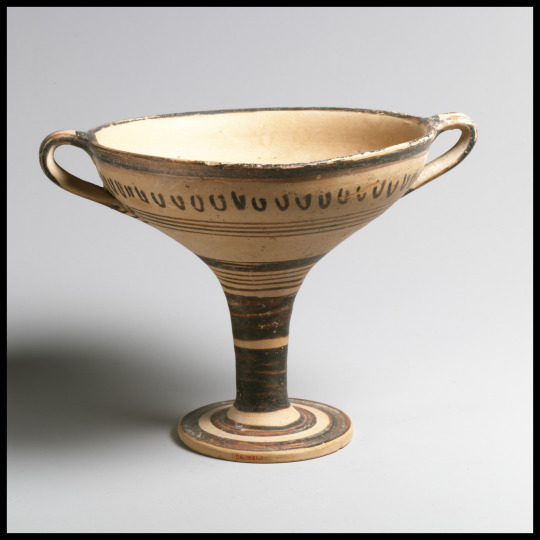
Wine in Korithia predates both the Korithians and the Arkodians, and had already been developed by several cultures on the islands including the Awaxi mentioned earlier. Wine is one of the most commonly consumed beverages, only surpassed by water, and slightly more common than psamarla, a Korithian version of unfiltered beer. Wine has many social, religious, and economic uses and is essential in the trade of the plantbrew, making up the base of many kinds of potion. There are many varieties of wine, with some being viewed as better or worse than others. Red wine is typically preferred for later in the day as it is believed that it helps to induce sleep while white wine is preferred for the morning and afternoon. Wine is typically watered down at a ratio of 2 parts water to 1 part wine, this may be either with plain or salted water. Unwatered wine is saved for special occasions and certain religious ceremonies in which intoxication is the goal. Wine may be sweetened with honey, figs, or various fruit juices. Herbs and spices such as black pepper, tisparos, coriander, saffron, thyme, and even cannabis and opium and various magical herbs may be added to change the flavor of the wine and to promote other effects.
Recipe
Pick a wine that you like and put it in a glass or cup. You can water it down if you would like but I didn't because I am not Korithian and this was a special occasion.
I finally got this post done! If you decided to read through this whole thing, thank you! Let me know if you try any of these, most of these amounts are ultimately a matter of taste, you can change things and experiment if you want.
Now we'll see if I get to 300 followers and we'll do this all over again with the food from another part of the Green Sea.
Thank you all again for following me, I've really enjoyed sharing my WIP with y'all!
@patternwelded-quill , @skyderman , @flaneurarbiter , @jclibanwrites , @alnaperera, @rhokisb, @blackblooms , @lord-nichron , @kosmic-kore , @friendlyshaped , @axl-ul , @talesfromtheunknowable , @wylanzahn , @dyrewrites , @foragedbonesblog , @kaylinalexanderbooks , @mk-writes-stuff , @roach-pizza
#fantasy food#writeblr#writing#worldbuilding#fantasy#testamentsofthegreensea#fantasy writing#world building#creative writing#story writing#200 followers#thank you guys so much!#fantasy world
86 notes
·
View notes
Text
Dcst Stardew Valley AU pt2
Featuring: a visit to the blacksmith's, the museum, the mines, and the feeling of dread at not knowing if a person who you used to be super close with would even care that you're back.
Taiju wakes up bright and early, showers, has some breakfast, checks his mail (making a mental note to send a letter to his grandparents later this week), and tends to his little patch of parsnips. Considering the geodes he’s collected from clearing rocks around the farm, he remembers Chrome talking about the blacksmith’s and decides to head over there.
On the way, Taiju accidentally manages to drop a geode in the river—oh, whoops. Ah well, it’s not a big de—what is that.
A large melon seems to be floating down the river, but then it pops up in front of Taiju to reveal a little girl holding his dropped geode!
Taiju thanks her for the assistance, and asks her name. She’s a bit shy, but says all the kids call her Suika, and remarks that she doesn’t know who Taiju is. Taiju says he’s the new farmer, and Suika asks if he has any cute animals on his farm. Taiju says not yet, but maybe in the future!
Suika then realizes she’s late for school, and rolls away in her melon, surprising Taiju. Kids sure can be quirky, he supposes.
Anyway Taiju makes his way to the blacksmith’s, where he finds an elderly man working away at the forge. The man stops when Taiju comes in, putting down his tools and greeting Taiju warmly. His name is Kaseki, and he’s very glad to meet this new farmer young Chrome’s been speaking about.
Speaking of Chrome, he pokes his head in from another room, cheerfully saying hi as he hauls in a box of gems. Taiju explains that he’s brought some geodes to crack open, and Chrome is very enthusiastic about it.
They get some stone, coal and copper ore, but the last geode contains something surprising—a small helmet.
Chrome is beside himself with excitement—how lucky that Taiju found an artifact! He should totally take it to the museum and ask the caretaker Ruri about it. Also maybe he could say hi to her for him? Kaseki teases Chrome about how close he is with Ruri, and Chrome laughs it off, but Taiju notices a slight flush on his cheeks.
He agrees to take the artifact to the museum, and then asks about what he can do with the copper and coal. Kaseki talks with him about tool upgrades and they discuss the mines, and how he’ll only be able to find certain ores and minerals at deeper levels. Taiju thanks them and heads over to the museum.
When Taiju enters the museum, he sees the library portion of the building is being occupied by a gaggle of children being tutored by a man with white hair and a yellow cap. They all turn at the sound of the door opening and stare at him.
“Oh, Mr. Farmer!” Suika waves. Taiju waves back, and apologizes for interrupting. The teacher, a man with white hair and a yellow cap, assures him it’s perfectly alright, but before he can resume his lesson the kids start asking Taiju tons of questions. What’s his name? Where did he come from? How big is his farm? What does he grow on it? Does he have a pet cow? Does he have kids?
“Alright everyone, settle down!” The teacher sighs. “Sorry, they haven’t met a new person in a while so they’re rather curious…”
Taiju laughs and says it’s fine, there’s nothing wrong with kids being curious. Since the class won’t settle down until they get some answers, he and the teacher decide to let the kids choose three questions and then they have to get back to the lesson.
First: What’s his name? Easy enough.
Second: How old is he? Also pretty easy. One kid says “Oh, I thought maybe you were older than Mr. Ukyo, but he’s really old so I guess that makes sense.” Mr. Ukyo, who appears to be in his late twenties/early thirties, laughs good-naturedly but looks like he just died inside a little.
Finally the last question. Where did you come from? Taiju says he came from Zuzu City, but he was actually born in Pelican Town.
“So why’d you leave?” A kid asks innocently. Taiju blinks.
“Uh, well…” he really doesn’t want to get into that…
Ukyo gently but firmly reminds the class that Mr. Taiju agreed to three questions, and now it’s time to go back to learning. Everyone pack up your things for the spring nature walk!
“Yaaaaaaay!!”
The class quickly rushes to line up buddy-system style, and with an apologetic wave to Taiju Ukyo bundles them out the door.
“I think you handled that pretty well,” a feminine voice says. Taiju turns around to see a young blonde woman at the museum counter, smiling at him warmly. To his surprise, she looks exactly like Byakuya’s wife Lillian, though she’s clearly a lot younger.
“Oh, um, thanks. You’re Ruri, right?”
“Yes, that’s me! What can I do for you?”
Taiju pulls out the helmet artifact. “Chrome from the blacksmith’s said you might be able to tell me something about this? Also he says hi.”
Ruri lights up, taking the helmet and poring over it carefully. “Oh, what a lovely find! This is a dwarven helm—perhaps two hundred years old, in fact!” She asks if he would mind donating it to the museum—you see, their old collection was stolen, and several of the library’s books were washed away in a flood. Chrome’s been trying to help and has actually donated a few of the best quality gems and artifacts he can find, but it’s slow going.
Taiju is happy to donate the dwarven helm and promises to bring anything else interesting he finds to Ruri, which she thanks him for.
“By the way, um…” Taiju hesitates. “Are you related to a Miss Lillian?”
“Oh, yes! She’s my aunt. We do look quite similar, don’t we?”
“Haha, yeah…um, well, I’m going up to the mines, thanks for your help!”
“Oh, wait!” If Taiju wants to do some mining then he should first head over to the Adventurer’s Guild—it’s not safe to go down without someone who’s experienced in combat. Monsters and all that. Ruri says her sister Kohaku is a part of the guild, she’ll write a letter for Taiju so that she’ll give him a discount for the first protector’s fee.
Taiju thanks her profusely and she says to think nothing of it. He’s Chrome’s friend, so that makes him her friend as well! Plus he did bring her a great artifact. She really needs all the help she can to rebuild the collection and recover the library’s books—the museum doesn’t get a lot of money these days with so few visitors, and Ukyo has been unable to get new books for the kids. She sighs and says it didn’t always used to be this way, and Taiju agrees—he silently recalls that when he was a kid, Senku loved going to the museum and looking at all the artifacts and gems, and reading from big books to Taiju and Yuzuriha about them.
Taiju bids Ruri farewell and heads up to the mountain with the letter for her sister. He makes it to the Adventurer’s Guild, where he finds a tall man in a black cape and mask, and a woman with pink hair. He asks if they know where Kohaku is, and both answer no. They’re a bit intimidating, so Taiju just excuses himself.
Hmm…maybe Kohaku is in the mines already? He enters the cave, where a blonde woman with a striking resemblance to Ruri is peering into a hole.
They introduce themselves, and after reading Ruri’s letter Kohaku agrees to take Taiju down into the mines, though she first gives him a rundown of what to expect from the various monsters inhabiting the cave system.
While in the mines Kohaku also suggests he could hold onto one her spare weapons, but Taiju is pretty reluctant to fight himself (also he’s preoccupied with the pickaxe), which Kohaku supposes she can respect. Chrome is apparently pretty bad at fighting himself, and he’s always asking for her help on his and Senku’s cave exploring adventures.
Wait, she knows…oh, that actually makes sense, Taiju realizes. He almost forgot that Yuzuriha had mentioned Chrome and Senku being friends. And Ruri and Kohaku are both friends with Chrome and Lillian’s nieces, so yeah it figures that they know Senku.
“You’re ah…friends with Senku, then?”
Kohaku scoffs. “Sure, I guess? He can be a real pain, but he’s family.” Something occurs to her. “Why do you ask? Did he do something to you?”
Oh Yoba, no, it’s not that! Taiju stumbles over his words a bit before admitting that he used to be friends with Senku when they were kids, before Taiju moved to Zuzu City.
Kohaku stops for a second and squints at him. Then her eyes widen. “Oh! You’re that kid!”
Huh?
The kid from the photo album, she means—when Aunt Lillian was dating Byakuya their families started spending holidays together, and he often told stories of Senku’s childhood, which included various shenanigans involving Taiju and Yuzuriha.
Taiju’s pretty surprised to hear this—he already learned that Yuzuriha didn’t just forget him, but to think that a complete stranger knows about his childhood because Byakuya talked about him so much throws him a bit.
After a while, he asks quietly, “Did…Senku ever talk about me?”
Kohaku looks over at him. “Well…uh. Not really, no?”
“…Oh.”
“Hey, wait, I didn’t mean—“ She frowns. “It’s like, all that stuff was childhood stories, and Senku’s the kind of guy who likes living in the present moment, you know? And, sure, Ruri and I are his cousins, but he’s way closer with Chrome and Yuzuriha. He’s more likely to reminisce with them than with me.”
Right, yeah, that makes sense. Taiju apologizes for suddenly bringing the mood down with his personal issues, and Kohaku tells him to relax. She kinda gets it, yknow? She has a friend named Amaryllis who lives in the Desert—they rarely get to visit each other, especially with how poorly managed local transportation is, so they mostly communicate through other means.
“Yeah but…I didn’t visit. Or write. Or call. I just…left.”
Taiju doesn’t know why he’s suddenly opening up to someone he barely knows. Maybe the mines are getting to him. But Kohaku is surprisingly sympathetic. Saying it’s none of her business why he didn’t stay in touch with his friends unless he wants to talk about that, and focusing on the fact that he’s here now. Does he want to talk to Senku? They could like…uhhh. Go over to his house after this. Well, he might not be home by then, it’s really difficult to track Senku down actually, but she’ll go with him.
Taiju says he does want to talk to Senku—besides, if he’s going to be friends with Yuzuriha, Chrome, and now Ruri and Kohaku it’s not like he can avoid Senku. But…maybe not today.
“Okay. For what it’s worth, you seem like a nice guy, Taiju. Not the sort of person who would ghost someone on purpose. I don’t think Senku holds it against you.”
“…Thank you, Kohaku.”
The day comes to a close, with Taiju having collected a modest amount of stone, coal, and copper. He thanks Kohaku for her help, and heads on home.
As he lies in bed, Taiju reflects on his feelings. Why does he feel so much more awkward about seeing Senku again than he did with Yuzuriha? Maybe it’s because with Yuzuriha he didn’t really have time to worry about it before they ran into each other, and the energy she gave off was so positive that it dispelled most of his anxiety over reconnecting with her.
But maybe it’s also because…he kind of expected that from her. She was always really warm and sweet, and her social circle when they were kids was far wider than his and Senku’s. Of course it’d make sense that she’d be open to being friends again, even if Taiju hasn’t really properly apologized for losing touch.
But with Senku, it feels like there’s something he missed out on that Taiju has trouble putting into words. He really did think Senku would be gone by now, off doing some really fancy important research and becoming a globally renowned scientist. But Senku stayed for some reason, and not only that, he has all these new people in his life that weren’t there when Taiju last saw him. Yuzuriha was always more popular—Senku really just had them and his dad. So now that he has all these other people…would he really need Taiju in his life again?
It suddenly occurs to Taiju that Byakuya would have almost certainly told Senku about Taiju coming into the store yesterday, and something in his chest tightens.
Would it be worse if Senku didn’t want to see him and actively avoided him, or if he didn’t care either way? Oh Yoba, what if Senku thinks Taiju is avoiding him since he didn’t come into the store today?
Taiju rolls over and sighs. Maybe he’s overthinking things. Better try to put his feelings into action, right? Tomorrow…he’ll go to Ishigami General Store.
12 notes
·
View notes
Text
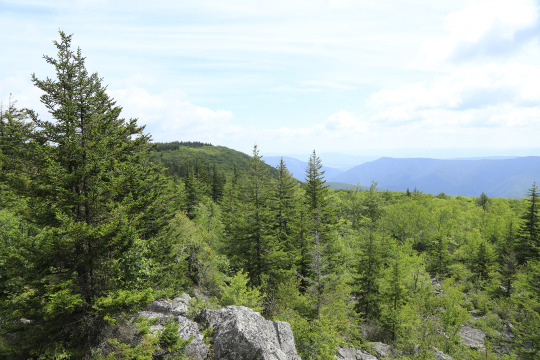
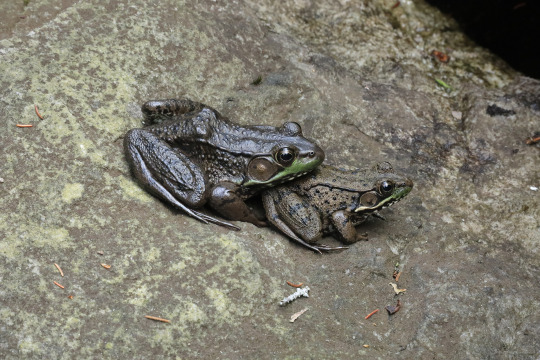
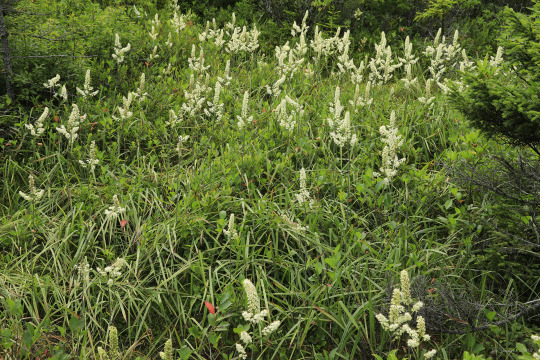
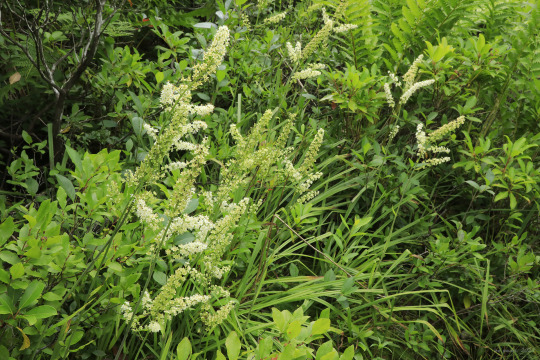

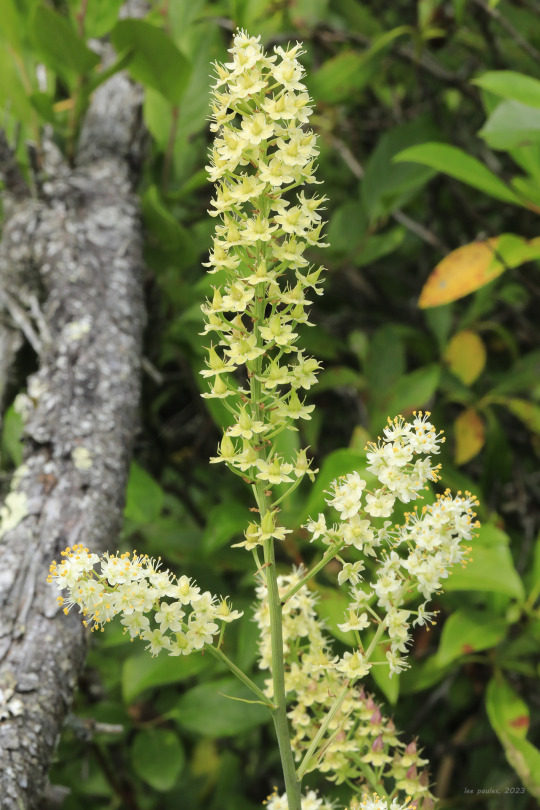

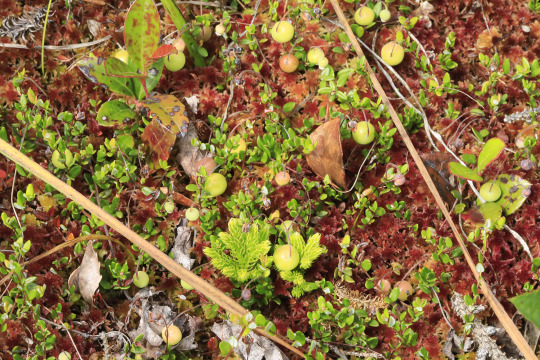


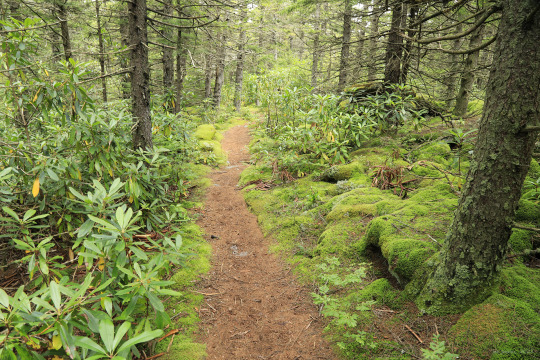
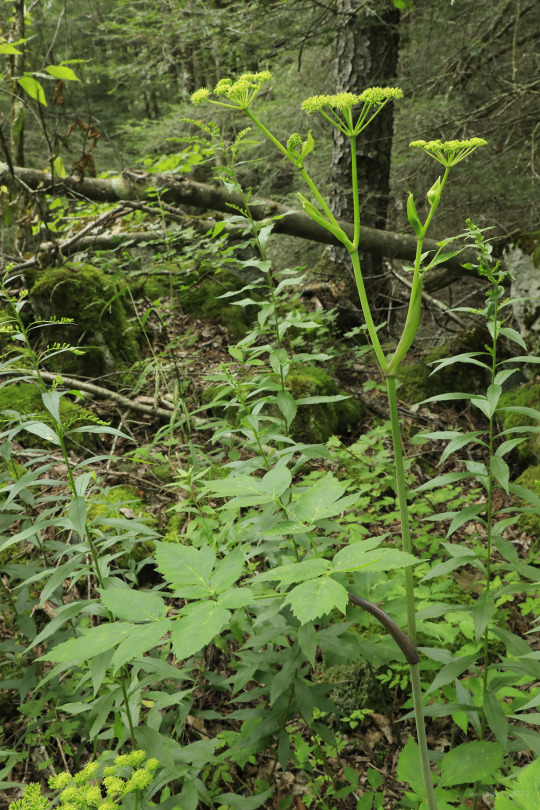
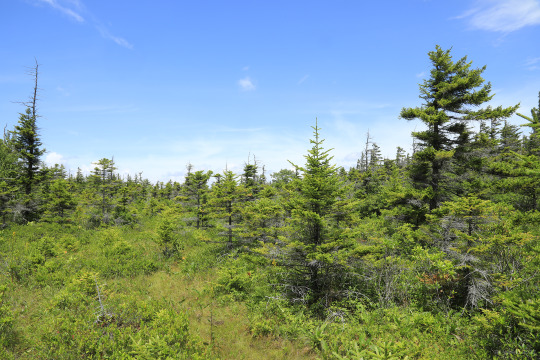
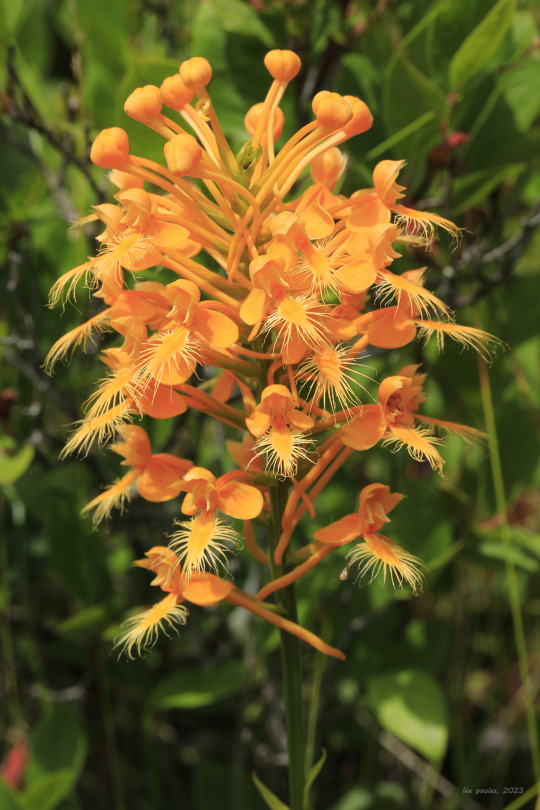

Hazy mid-summer day on the Sods, Part 1.
Photos are from the South Prong Trail, heading towards Roaring Plains. The pine barrens death camas (Stenanthium leimanthoides) growing in the bogs and seeps of the Plains is simply stunning this year. Such a toxic little beauty - death incarnate. Also, the mountain angelica (Angelica triquinata) is getting ready to bloom - I think of this tall, Appalachian endemic as the mid to late summer counterpart of cow parsnip. And how about that fabulous orange-fringed orchid (Platanthera ciliaris), which is just now reaching peak bloom in our high-elevation mountain bogs? The showy perennial is more commonly referred to as yellow-fringed orchid, but I have no clue why; every plant I've found in this neck of the woods has a hue similar to a Sunkist navel orange.
#appalachia#vandalia#west virginia#wildflowers#flora#summer#monongahela national forest#allegheny mountains#roaring plains#dolly sods#amphibian#northern green frog#pine barrens death camas#small green wood orchid#club-spur orchid#small cranberry#round-leaved sundew#roundleaf sundew#dewdrop#false violet#mountain angelica#filmy angelica#orange-fringed orchid#yellow-fringed orchid#bog goldenrod
208 notes
·
View notes



